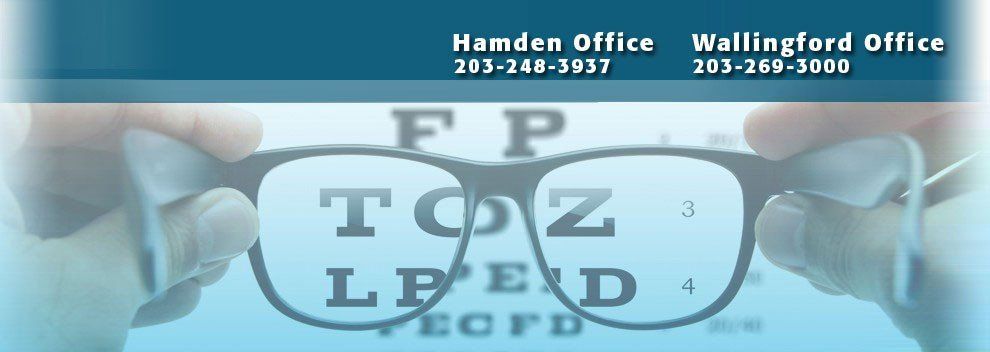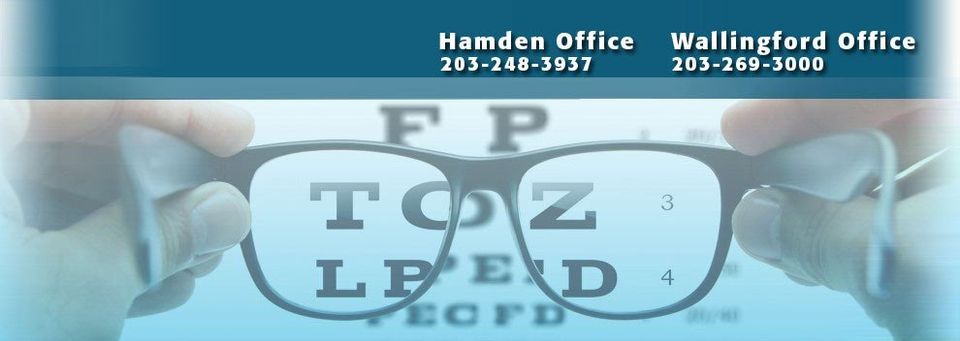Hamden Office
203-248-3937
Wallingford Office 203-269-3000


FAQ
Do you check for glaucoma, cataracts, and/or macular degeneration in your exam?
Yes, our examinations look at your eye health as well as your visual needs (refraction, contact lenses). We perform tonometry to check your eye pressure to partially determine your risk of developing glaucoma. We also dilate your pupils to evaluate the optic nerves, retina, lens, and vasculature. From this we can determine your eye health status in respect to the above and other disease processes.
What is a ‘refraction’?
A refraction is the process used to determine your eyeglass prescription . It is actually much more complex than it would seem: it incorporates checking your vision (‘visual acuities’) through your current prescription, verifying the prescription in those glasses (‘lensometry’), obtaining an ‘objective’ measure of your prescription (‘automated refractor testing or static retinoscopy’), determining your best ‘subjective’ measure of your prescription (“which is better, one or two?”), testing you for any specific visual needs (computer use, hobbies, work environments, protective eyewear, light control eyewear, and other needs), and establishing your ‘final prescription or prescriptions’.
Why do you dilate? How long does it last? Can I drive after being dilated? How often do you have to dilate?
Under normal circumstances, if you expose your eyes to light, the pupil will constrict to limit how much light goes into your eye. When we need to examine the inside of your eyes, we need to shine a light through that pupil so examine the structures. In order to see this clearly and with stereopsis (depth perception or ‘3D’), we need to make the pupil stay open using eyedrops. Our view before dilation is similar to looking into a room through a keyhole using only one eye. After dilating the pupil the view is like opening the door and putting your head in the room to look around. To adequately evaluate those structures we need to dilate.
The dilation process requires us to instill eyedrops and wait for the pupil to open. The pupil will start to dilate within 5 minutes and peaks at about 20 minutes. Once your pupil is dilated we examine your eyes.
The side effects of the dilation vary based on your age. Under the age of 45 it will blur your near vision (reading) when you are wearing your glasses and will make you sensitive to bright light. Over the age of 45 it will typically only make you sensitive to bright light as your eyeglasses will help to correct the reading. This blurred reading vision lasts for about 90 minutes and the light sensitivity lasts about 4 hours.
We do not recommend that you drive after being dilated due to these complications. Most people do drive, but if you have never driven dilated, we strongly urge that you bring a driver or return to be dilated another day when someone will drive you. Remember to bring sunglasses with you, if you have them.
Most eye care professionals dilate your pupils annually. The health risks for the eye increase with age, so this is absolutely more important as you age.
Some instruments can take images of the retina without dilation. As part of our pretesting we take ‘fundus photographs’. Some current scanning laser instruments are capable of obtaining 2 dimensional images of nearly 80% of the retina. These are wonderful technologies, but do not replace a 3-dimensional evaluation of the retina when performed by the doctor with an indirect ophthalmoscope (but keep your eyes peeled as technology continues to advance and this could change).
Do you examine eyes for the effects of diabetes?
Absolutely. Diabetes can seriously affect your vision. If you have diabetes, you need to have a dilated retinal examination every year, or more often if recommended by your doctor. After your examination we will communicate the status of your examination to your primary care practitioner(PCP) as well as your endocrinologist, if you have one.
If you have never been diagnosed with diabetes, it is possible to have your vision change as one of the earliest symptoms. Usually, this is not the first indication that you have diabetes. Your best method of detecting diabetes is by having routine physical examinations with your PCP for blood work and urinalysis.
What is the difference between a routine eye examination through a vision care insurance (like VSP, DavisVision, or EyeMed) and a medical eye evaluation?
Many employers will provide their employees with specific eye care insurance covering the routine eye examinations at various intervals (typically every one or two years). These vision insurances frequently cover a portion or all of the cost of eyeglasses or contact lenses, as well. If you have no eye health risks or problems, then your examination should be covered entirely through your vision insurance with only the cost of copayments or overages they charge.
If, during the course of your examination, other problems or risks emerge (glaucoma risk, retinal tears, dry eye, or other pathologies), additional testing may be indicated. These other tests may occur on the same day or be scheduled for a future time. The examination will frequently still be covered by your vision insurance, but the additional testing indicated by the new-found problem will usually be submitted to your regular medical insurance and be subject to the copayments or deductibles specific to your plan.
Are contact lens evaluations covered by the routine eye examination?
No. Contact lens care is separate. However, many of the tests used in evaluating an individual for contact lenses are also part of the eye examination, so the cost of the contact lens evaluation is reduced when both are performed at the same time.
How do I prepare for my visit?
Go to the ‘Home’ screen of this website and download the exam forms to fill out (unless you did so last year). You can read about what occurs in a routine examination by going to the ‘professional services’ screen of this website. And remember to bring sunglasses.
Contact Information
Dr. James D. Weston
Dr. Thomas R. Conrod
Hamden Eye Associates
2300 Dixwell Ave.
Hamden, CT 06514
At the Hamden Mart
Phone:
203-248-3937
Hours:
- Monday
- -
- Tuesday
- -
- Wednesday
- -
- Thursday
- -
- Friday
- -
- Saturday
- -
- Sunday
- Closed
Wallingford Eye Associates
314 Main St.
Yalesville, CT 06492
At Route 150,
Next to the New Post Office,
Just Off Route 68
Phone: 203-269-3000
Hours:
- Monday
- -
- Tuesday
- -
- Wednesday
- -
- Thursday
- Closed
- Friday
- -
- Saturday
- -
- Sunday
- Closed
Office closes 12 :30 – 1 :30 daily for lunch
Content, including images, displayed on this website is protected by copyright laws. Downloading, republication, retransmission or reproduction of content on this website is strictly prohibited. Terms of Use
| Privacy Policy